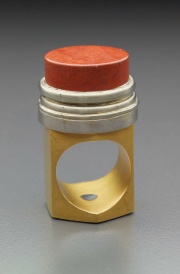Difference between revisions of "Yellow gold"
Jump to navigation
Jump to search
(username removed) |
|||
| (2 intermediate revisions by one other user not shown) | |||
| Line 1: | Line 1: | ||
| − | [[File:2006.385-SC178143.jpg|thumb| | + | [[File:2006.385-SC178143.jpg|thumb|Pencil ring<br>MFA# 2006.385]] |
== Description == | == Description == | ||
| − | A [ | + | A [[gold|gold]] alloy that is yellow in color. Yellow gold compositions can range from pure gold (24 carat) to about 20% gold (~5 carat). It is usually alloyed with [[silver|silver]] (Ag) and [[copper|copper]] (Cu) and occasionally [[zinc|zinc]] (Zn). The color shade, hardness, and ductility vary with composition. In general, the strength of the alloy increases with higher percentage of alloying components. |
| + | |||
| + | Some compositions for yellow gold are: | ||
| + | * Yellow gold (24k): Au (100%), very soft and malleable (density=19.23, m.p.= 1064C) | ||
| + | * Yellow gold (22k): Au with Ag (8.4%) | ||
| + | * Yellow gold (22k): Au with Ag (5.5%), Cu (2.8%) (density=17.9, m.p.= 995-1020C) | ||
| + | * Yellow gold (22k): Au with Ag (5.0%), Cu (2.0%) and Zn (1.3%) | ||
| + | * Dark yellow gold (22K): Au with Ag (3.2%), Cu (5.1% ) (density=17.8, m.p.= 964-982C) | ||
| + | * Yellow pink gold (21K): Au with Ag (4.5%), Cu (8.0%) (density=16.8, m.p.= 940-964C) | ||
| + | * Green-yellow gold (18k): Au with Ag (25.0%) | ||
| + | * Pale yellow gold (18K): Au with Ag (16.0%), Cu (9.0%); (density=15.6, m.p.= 895-920C) | ||
| + | * Yellow gold (18K): Au with Ag (12.5%), Cu (12.5%); (density=15.45, m.p.= 885-895C) | ||
| + | * Yellow gold (14K): Au with Ag (30.0%), Cu (11.5%) | ||
| + | * Pale yellow gold (9K): Au with Ag (55.0%), Cu (7.5%) | ||
| + | * Yellow gold (9K): Au with Ag (42.5%), Cu (20.0%) | ||
| + | * Rich yellow gold (9K): Au with Ag (31.25%), Cu (31.25%) | ||
| + | * Imitation yellow gold (~5K): Au (17-25%), Ag (10-27%), Cu (40-60%), Zn (3-12%) | ||
== Synonyms and Related Terms == | == Synonyms and Related Terms == | ||
| Line 8: | Line 24: | ||
Gelbgold (Deut.) | Gelbgold (Deut.) | ||
| − | == | + | ==Resources and Citations== |
* ''A History of Technology'', Charles Singer, E.J. Holmyard, A.R. Hall (eds.), Clarendon Press, Oxford, Volume 1: From Early times to Fall of Ancient Empires, 1954 | * ''A History of Technology'', Charles Singer, E.J. Holmyard, A.R. Hall (eds.), Clarendon Press, Oxford, Volume 1: From Early times to Fall of Ancient Empires, 1954 | ||
Latest revision as of 11:34, 22 June 2022
Description
A Gold alloy that is yellow in color. Yellow gold compositions can range from pure gold (24 carat) to about 20% gold (~5 carat). It is usually alloyed with Silver (Ag) and Copper (Cu) and occasionally Zinc (Zn). The color shade, hardness, and ductility vary with composition. In general, the strength of the alloy increases with higher percentage of alloying components.
Some compositions for yellow gold are:
- Yellow gold (24k): Au (100%), very soft and malleable (density=19.23, m.p.= 1064C)
- Yellow gold (22k): Au with Ag (8.4%)
- Yellow gold (22k): Au with Ag (5.5%), Cu (2.8%) (density=17.9, m.p.= 995-1020C)
- Yellow gold (22k): Au with Ag (5.0%), Cu (2.0%) and Zn (1.3%)
- Dark yellow gold (22K): Au with Ag (3.2%), Cu (5.1% ) (density=17.8, m.p.= 964-982C)
- Yellow pink gold (21K): Au with Ag (4.5%), Cu (8.0%) (density=16.8, m.p.= 940-964C)
- Green-yellow gold (18k): Au with Ag (25.0%)
- Pale yellow gold (18K): Au with Ag (16.0%), Cu (9.0%); (density=15.6, m.p.= 895-920C)
- Yellow gold (18K): Au with Ag (12.5%), Cu (12.5%); (density=15.45, m.p.= 885-895C)
- Yellow gold (14K): Au with Ag (30.0%), Cu (11.5%)
- Pale yellow gold (9K): Au with Ag (55.0%), Cu (7.5%)
- Yellow gold (9K): Au with Ag (42.5%), Cu (20.0%)
- Rich yellow gold (9K): Au with Ag (31.25%), Cu (31.25%)
- Imitation yellow gold (~5K): Au (17-25%), Ag (10-27%), Cu (40-60%), Zn (3-12%)
Synonyms and Related Terms
Gelbgold (Deut.)
Resources and Citations
- A History of Technology, Charles Singer, E.J. Holmyard, A.R. Hall (eds.), Clarendon Press, Oxford, Volume 1: From Early times to Fall of Ancient Empires, 1954
